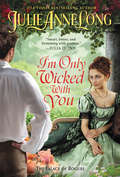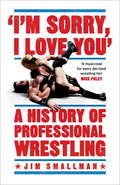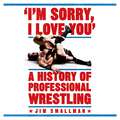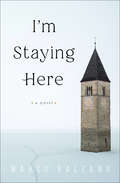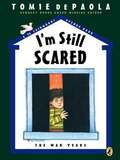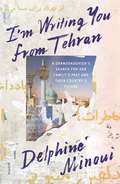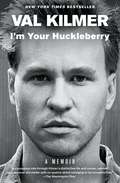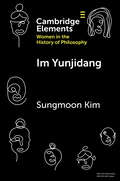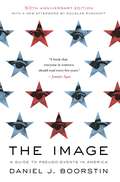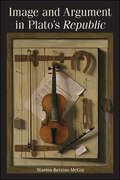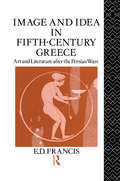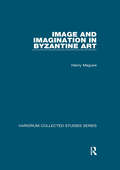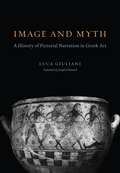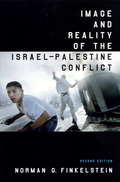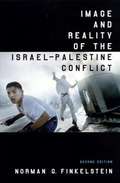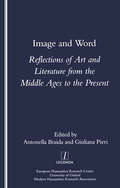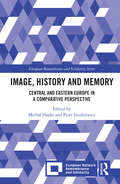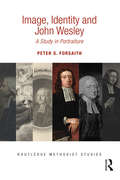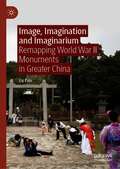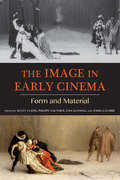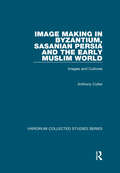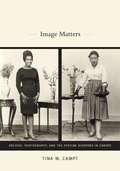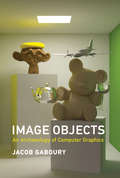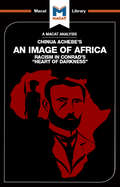- Table View
- List View
I'm Only Wicked with You: The Palace of Rogues (The Palace of Rogues #3)
by Julie Anne LongUSA Today bestselling author Julie Anne Long continues her Palace of Rogues series with a brand-new romance about an ambitious American and a headstrong British heiress.He’s the battle-hardened son of a bastard, raised in the wilds of New York. She’s the sheltered, blue-blooded darling of the London broadsheets, destined to marry a duke. Their worlds could only collide in a boardinghouse by the London docks...and when they do, the sparks would ignite all of England. Nothing can stop Hugh Cassidy’s drive to build an American empire...unless it’s his new nemesis, the arrogant, beautiful, too-clever-by-half Lady Lillias Vaughn. The fascination is mutual. The temptation is merciless. And the inevitable indiscretion? Soul-searing—and the ruination of them both. Hugh’s proposal salvages Lillias’s honor but kills their dreams for their futures...until they arrive at a plan that could honorably set them free. But unraveling their entanglement inadvertently uncovers enthralling truths: about Lillias’s wounded, tender heart and fierce spirit. About Hugh’s stunning gentleness, depth, and courage. Soon Hugh knows that as surely as he’d fight a thousand battles to win her...the best way to love Lillias means breaking his own heart.
I'm Sorry, I Love You: A must-read' - Mick Foley
by Jim Smallman'Clever, funny, authoritative and illuminating' - Times Literary Supplement 'Filled with passion, humour, and a little bit of welcome weirdness. A must-read for every die-hard wrestling fan' - Mick FoleyFor fans of books from Chris Jericho, Steve Austin, Daniel Bryan, Mick Foley and Jim Ross. 'We have all felt every emotion today. Remember today, the next time a family member or workmate tells you that wrestling is stupid. We've laughed, we've cried, we've screamed our lungs out. Professional wrestling is the greatest thing in the entire world.' - Jim Smallman, 2016 Comedian and PROGRESS Wrestling founder Jim Smallman takes us on a wild ride through the history of pro-wrestling, from its beginnings at the turn of the twentieth century to the pop-culture, pay-per-view juggernaut that it is today.Join Jim as he looks at the most defining and iconic moments in wrestling's history and attempts to nail down just why this ludicrous, over the top, compelling quasi-sport means so much to so many people.
I'm Sorry, I Love You: A must-read' - Mick Foley
by Jim SmallmanFor fans of books from Chris Jericho, Steve Austin, Daniel Bryan, Mick Foley and Jim Ross. 'We have all felt every emotion today. Remember today, the next time a family member or workmate tells you that wrestling is stupid. We've laughed, we've cried, we've screamed our lungs out. Professional wrestling is the greatest thing in the entire world.' - Jim Smallman, 2016 Comedian and PROGRESS Wrestling founder Jim Smallman takes us on a wild ride through the history of pro-wrestling, from its beginnings at the turn of the twentieth century to the pop-culture, pay-per-view juggernaut that it is today.Join Jim as he looks at the most defining and iconic moments in wrestling's history and attempts to nail down just why this ludicrous, over the top, compelling quasi-sport means so much to so many people.(P)2018 Headline Publishing Group Ltd
I'm Staying Here: A Novel
by Marco BalzanoA mother recounts her life story to her long-lost daughter in this sweeping historical novel about a community torn between Italian fascism and German Nazism. In the small village of Curon in South Tyrol, seventeen-year-old Trina longs for a different life. She dedicates herself to becoming a teacher, but the year that she qualifies—1923—Mussolini&’s regime abolishes the use of German as a teaching language in the annexed Austrian territory. Defying their ruthless program of forced Italianization, Trina works for a clandestine network of schools in the valley, always with the risk of capture. In spite of this new climate of fear and uncertainty, she finds love and some measure of stability with Erich, an orphaned young man and her father&’s helper. Now married and a mother, Trina&’s life is again thrown into uncertainty when Hitler&’s Germany announces the &“Great Option&” in 1939, and communities in South Tyrol are invited to join the Reich and leave Italy. The town splits, and ever-increasing rifts form among its people. Those who choose to stay, like Trina and her family, are seen as traitors and spies; they can no longer leave the house without suffering abuse. Then one day Trina comes home and finds that her daughter is missing… Inspired by the striking image of the belltower rising from Lake Resia, all that remains today of the village of Curon, Marco Balzano has written a poignant novel that beautifully interweaves great moments in history with the lives of everyday people.
I'm Still Scared
by Tomie DepaolaFirst-grader tomie depaola experiences uncertainty in the weeks following the attack on pearl Harbor, December 7, 19 1. what are the grown-ups talking quietly about at home and even at school? why does his class have to go to the spooky furnace room for an air raid drill? why does the family hang thick black curtains over the windows? tomie?s mother is there to comfort and explain the confusion, and tomie feels better. but he?s still scared.
I'm Writing You from Tehran: A Granddaughter's Search for Her Family's Past and Their Country's Future
by Delphine MinouiA lucid, moving view into an often obscured part of our world, exploring notions of democracy, identity, and the resilience of the human spiritIn the wake of losing her beloved grandfather, Delphine Minoui decided to visit Iran for the first time since the revolution. It was 1998. She was twenty-two and a freshly minted journalist. She would stay for ten years.Quickly absorbed into the everyday life of the city, Minoui attends secret dance parties that are raided by the morality police and dines in the home of a young couple active in the Basij—the fearsome militia. She befriends veteran journalists battling government censorship, imprisoned student poets, and her own grandmother (a woman who is discovering the world of international affairs through her contraband satellite TV).And so it is all the more crushing when the political situation falters. Minoui joins street protests teeming with students hungry for change and is interrogated by the secret police; she sees a mirrored rise in the love of country—the yearning patriotism of the left, the militant nationalism of the right. Friends disappear; others may be tracking her movements. She finds love, loses her press credentials, marries, and is separated from her husband by erupting global conflict. Through it all, her love for Iran and its people deepens. In her family’s past she discovers a mission that will shape her entire future.Framed as a letter to her grandfather and filled with disarming characters in momentous times, I’m Writing You from Tehran is a remarkable blend of global history, family memoir, and the making of a reporter, told by someone both insider and outsider—a child of the diaspora who is a world-class political journalist.
I'm Your Huckleberry: A Memoir
by Val KilmerLegendary actor Val Kilmer shares the stories behind his most beloved roles, reminisces about his star-studded career and love life, and reveals the truth behind his recent health struggles in a remarkably candid autobiography.Val Kilmer has played many iconic roles over his nearly four-decade film career. A table-dancing Cold War agent in Top Secret! A troublemaking science prodigy in Real Genius. A brash fighter pilot in Top Gun. A swashbuckling knight in Willow. A lovelorn bank robber in Heat. A charming master of disguise in The Saint. A wise-cracking detective in Kiss Kiss Bang Bang. Of course, Batman, Jim Morrison and the sharp-shooting Doc Holliday. But who is the real Val Kilmer? With I&’m Your Huckleberry—published ahead of next summer&’s highly anticipated sequel Top Gun: Maverick, in which Kilmer returns to the big screen as Tom &“Iceman&” Kazansky—the enigmatic actor at last steps out of character and reveals his true self. In this uniquely assembled memoir—featuring vivid prose, snippets of poetry and rarely-seen photos—Kilmer reflects on his acclaimed career, including becoming the youngest actor ever admitted to the Juilliard School&’s famed drama department, determinedly campaigning to win the lead part in The Doors, and realizing a years-long dream of performing a one-man show as his hero Mark Twain. He shares candid stories of working with screen legends Marlon Brando, Tom Cruise, Robert Downey Jr. and Robert De Niro, and recounts high-profile romances with Cher, Cindy Crawford, Daryl Hannah, and former wife Joanne Whalley. He chronicles his spiritual journey and lifelong belief in Christian Science, and describes travels to far-flung locales such as a scarcely inhabited island in the Indian Ocean where he suffered from delirium and was cared for by the resident tribe. And he reveals details of his recent throat cancer diagnosis and recovery—about which he has disclosed little until now. While containing plenty of tantalizing celebrity anecdotes, I&’m Your Huckleberry—taken from the famous line Kilmer delivers as Holliday in Tombstone—is ultimately a singularly written and deeply moving reflection on mortality and the mysteries of life.
Im Yunjidang (Elements on Women in the History of Philosophy)
by Sungmoon KimThis Element aims to critically examine the philosophical thought of Im Yunjidang 任允摯堂 (1721–93), a female Korean Neo-Confucian philosopher from the Chosŏn 朝鮮 dynasty (1392–1910), and to present her as a feminist thinker. Unlike most Korean women of her time, Yunjidang had the exceptional opportunity to be introduced to a major philosophical debate among Korean Neo-Confucians, which was focused on two core questions-whether sages and commoners share the same heart-mind, and whether the natures of human beings and animals are identical. In the course of engaging in this debate, she was able to reformulate Neo-Confucian metaphysics and ethics of moral self-cultivation, culminating in her bold ideas of the moral equality between men and women and the possibility of female sagehood. By proposing a 'stage-approach' to feminism that is also sensitive to the cultural context, this Element shows that Yunjidang's philosophical thought could be best captured in terms of Confucian feminism.
The Image: A Guide to Pseudo-Events in America
by Daniel J. BoorstinFirst Published In 1962, This Wonderfully Provocative Book Introduced The Notion Of "pseudo-events" -- Events Such As Press Conferences And Presidential Debates, Which Are Manufactured Solely In Order To Be Reported -- And The Contemporary Definition Of Celebrity As "a Person Who Is Known For His Well-knownness. " Since Then Daniel J. Boorstin's Prophetic Vision Of An America Inundated By Its Own Illusions Has Become An Essential Resource For Any Reader Who Wants To Distinguish The Manifold Deceptions Of Our Culture From Its Few Enduring Truths.
Image and Argument in Plato's Republic (SUNY series in Ancient Greek Philosophy)
by Marina Berzins McCoyAlthough Plato has long been known as a critic of imagination and its limits, Marina Berzins McCoy explores the extent to which images also play an important, positive role in Plato's philosophical argumentation. She begins by examining the poetic educational context in which Plato is writing and then moves on to the main lines of argument and how they depend upon a variety of uses of the imagination, including paradigms, analogies, models, and myths. McCoy takes up the paradoxical nature of such key metaphysical images as the divided line and cave: on the one hand, the cave and divided line explicitly state problems with images and the visible realm. On the other hand, they are themselves images designed to draw the reader to greater intellectual understanding. The author gives a perspectival reading, arguing that the human being is always situated in between the transcendence of being and the limits of human perspective. Images can enhance our capacity to see intellectually as well as to reimagine ourselves vis-à-vis the timeless and eternal. Engaging with a wide range of continental, dramatic, and Anglo-American scholarship on images in Plato, McCoy examines the treatment of comedy, degenerate regimes, the nature of mimesis, the myth of Er, and the nature of Platonic dialogue itself.
Image and Idea in Fifth Century Greece: Art and Literature After the Persian Wars
by E. D. FrancisFirst published in 1990. Routledge is an imprint of Taylor & Francis, an informa company.
Image and Imagination in Byzantine Art (Variorum Collected Studies #866)
by Henry MaguireThe twelve studies contained in this second collection by Henry Maguire are linked together by a common theme, namely the relationship of Byzantine art to the imaginary. They show how art enabled the Byzantines not only to imagine the sacred events of the past, but also to visualize the invisible present by manifesting the spiritual world that they could not see. The articles are grouped around the following five topics: the depiction of nature by the Byzantines before and after iconoclasm, especially in portrayals of the earthly and the spiritual Paradise; the social functions and theological significance of classical artistic forms in Byzantine art after iconoclasm; the association between rhetoric and the visual arts in Byzantium, especially in contrast to the role played by liturgical drama in western medieval art; the relationship of the visual arts to Byzantine concepts of justice and the law, both human and divine; and portrayals of the two Byzantine courts, the imperial court on earth and the imagined court in heaven. The papers cover a wide range of media, including floor and wall mosaics, paintings in manuscripts and churches, ivory carvings, coins, and enamel work.
Image and Myth: A History of Pictorial Narration in Greek Art
by Luca Giuliani translated by Joseph O'DonnellOn museum visits, we pass by beautiful, well-preserved vases from ancient Greece but how often do we understand what the images on them depict? In "Image and Myth," Luca Giuliani tells the stories behind the pictures, exploring how artists of antiquity had to determine which motifs or historical and mythic events to use to tell an underlying story while also keeping in mind the tastes and expectations of paying clients. Covering the range of Greek style and its growth between the early Archaic and Hellenistic periods, Giuliani describes the intellectual, social, and artistic contexts in which the images were created. He reveals that developments in Greek vase painting were driven as much by the times as they were by tradition the better-known the story, the less leeway the artists had in interpreting it. As literary culture transformed from an oral tradition, in which stories were always in flux, to the stability of written texts, the images produced by artists eventually became nothing more than illustrations of canonical works. At once a work of cultural and art history, "Image and Myth" builds a new way of understanding the visual culture of ancient Greece. "
Image and Reality of the Israel-Palestine Conflict
by Norman FinkelsteinThis acclaimed study surveys the dominant popular and scholarly images of the Israel-Palestine conflict. Finkelstein opens with a theoretical discussion of Zionism, locating it as a romantic form of nationalism that assumed the bankruptcy of liberal democracy. He goes on to look at the demographic origins of the Palestinians, with particular reference to the work of Joan Peters, and develops critiques of the influential studies of both Benny Morris and Anita Shapira. Reviewing the diplomatic history with Aban Eban's oeuvre as his foil, Finkelstein closes by demonstrating that the casting of Israel as the innocent victim of Arab aggression in the June 1967 and October 1973 wars is not supported by the documentary record. This new edition critically reexamines dominant popular and scholarly images in the light of the current failures of the peace process.From the Trade Paperback edition.
Image and Reality of the Israel Palestine Conflict (2nd edition)
by Norman G. FinkelsteinFirst published in 1995, this polemical study challenges generally accepted truths of the Israel-Palestine conflict as well as much of the revisionist literature. This new edition critically re-examines dominant popular and scholarly images in the light of the current failures of the peace process.
Image and Word: Reflections of Art and Literature
by Antonella Braida"What was the role of images in the Western tradition? And how did they relate to the printed work? The essays in this wide-ranging collection address these questions by presenting a variety of material, including visual representations that can be read as texts and traditional book illustrations. The editors offer a critical review of visual arts and texts, encompassing thirteenth-century Spanish miniatures, Italian Renaissance painting and book illustrations, the explosion of inter-arts comparisons in the nineteenth century in the works of such diverse writers as Blake, Mallarme and D'Annunzio, and the modern debate on the visual arts."
Image, History and Memory: Central and Eastern Europe in a Comparative Perspective (European Remembrance and Solidarity)
by Michał Haake Piotr JuszkiewiczThis book discusses the active relationship among the mechanics of memory, visual practices, and historical narratives. Reflection on memory and its ties with historical narratives cannot be separated from reflection on the visual and the image as its points of reference which function in time. This volume addresses precisely that temporal aspect of the image, without reducing it to a neutral trace of the past, a mnemotechnical support of memory. As a commemorative device, the image fixes, structures, and crystalizes memory, turning the view of the past into myth. It may, however, also stimulate, transform, and update memory, functioning as a matrix of interpretation and understanding the past. The book questions whether the functioning of the visual matrices of memory can be related to a particular historical and geographical scope, that is, to Central and Eastern Europe, and whether it is possible to find their origin and decide if they are just local and regional or perhaps also Western European and universal. It focuses on the artistic reflection on time and history, in the reconstructions of memory due to change of frontiers and political regimes, as well as endeavours to impose some specific political structure on territories which were complex and mixed in terms of national identity, religion and social composition. The volume is ideal for students and scholars of memory studies, history and visual studies.
Image, Identity and John Wesley: A Study in Portraiture (Routledge Methodist Studies Series)
by Peter S. ForsaithThe face of John Wesley (1703–91), the Methodist leader, became one of the most familiar images in the English-speaking and transatlantic worlds through the late eighteenth and nineteenth centuries. After the dozen or so painted portraits made during his lifetime came numbers of posthumous portraits and moralising ‘scene paintings’, and hundreds of variations of prints. It was calculated that six million copies were produced of one print alone – an 1827 portrait by John Jackson R.A. as frontispiece for a hymn book. Illustrated by nearly one hundred images, many in colour, with a comprehensive appendix listing known Wesley images, this book offers a much-needed comprehensive and critical survey of one of the most influential religious and public figures of eighteenth-century Britain. Besides chapters on portraits from the life and after, scene paintings and prints, it explores aspects of Wesley’s (and Methodism’s) attitudes to art, and the personality cult which gathered around Wesley as Methodism expanded globally. It will be of interest to art historians as a treatment of an individual sitter and subject, as well as to scholars engaged in Wesley and Methodist studies. It is also significant for the field of material studies, given the spread and use of the image, on artefacts as well as on paper.
Image, Imagination and Imaginarium: Remapping World War II Monuments in Greater China
by Lu PanThis book explores five cases of monument and public commemorative space related to World War II (WWII) in contemporary China (Mainland), Hong Kong and Taiwan, all of which were built either prior to or right after the end of the War and their physical existence still remains. Through the study on the monuments, the project illustrates past and ongoing controversies and contestations over Chinese nation, sovereignty, modernism and identity. Despite their historical affinities, the three societies in question, namely, Mainland China, Hong Kong and Taiwan, vary in their own ways of telling, remembering and forgetting WWII. These divergences are not only rooted in their different political circumstances and social experiences, but also in their current competitions, confrontations and integrations. This book will be of great interest to historians, sinologists and analysts of new Asian nationalism.
The Image in Early Cinema: Form and Material (Early Cinema in Review)
by Scott Curtis Philippe Gauthier Tom Gunning Joshua YumibeIn The Image in Early Cinema, the contributors examine intersections between early cinematic form, technology, theory, practice, and broader modes of visual culture. They argue that early cinema emerged within a visual culture composed of a variety of traditions in art, science, education, and image making. Even as methods of motion picture production and distribution materialized, they drew from and challenged practices and conventions in other mediums. This rich visual culture produced a complicated, overlapping network of image-making traditions, innovations, and borrowing among painting, tableaux vivants, photography, and other pictorial and projection practices. Using a variety of concepts and theories, the contributors explore these crisscrossing traditions and work against an essentialist notion of media to conceptualize the dynamic interrelationship between images and their context.
Image Making in Byzantium, Sasanian Persia and the Early Muslim World: Images and Cultures (Variorum Collected Studies #905)
by Anthony CutlerRelations between Byzantium and its neighbours are the focus of this volume. The papers address questions of cultural exchange, with special attention to art historical relations as shown by technical, iconographic and diplomatic exchanges. While addressed to specialists, both their approach and the language make these papers accessible to students at all levels.
Image Matters: Archive, Photography, and the African Diaspora in Europe
by Tina M. CamptIn Image Matters, Tina M. Campt traces the emergence of a black European subject by examining how specific black European communities used family photography to create forms of identification and community. At the heart of Campt's study are two photographic archives, one composed primarily of snapshots of black German families taken between 1900 and 1945, and the other assembled from studio portraits of West Indian migrants to Birmingham, England, taken between 1948 and 1960. Campt shows how these photographs conveyed profound aspirations to forms of national and cultural belonging. In the process, she engages a host of contemporary issues, including the recoverability of non-stereotypical life stories of black people, especially in Europe, and their impact on our understanding of difference within diaspora; the relevance and theoretical approachability of domestic, vernacular photography; and the relationship between affect and photography. Campt places special emphasis on the tactile and sonic registers of family photographs, and she uses them to read the complexity of "race" in visual signs and to highlight the inseparability of gender and sexuality from any analysis of race and class. Image Matters is an extraordinary reflection on what vernacular photography enabled black Europeans to say about themselves and their communities.
Image Objects: An Archaeology of Computer Graphics
by Jacob GabouryHow computer graphics transformed the computer from a calculating machine into an interactive medium, as seen through the histories of five technical objects.Most of us think of computer graphics as a relatively recent invention, enabling the spectacular visual effects and lifelike simulations we see in current films, television shows, and digital games. In fact, computer graphics have been around as long as the modern computer itself, and played a fundamental role in the development of our contemporary culture of computing. In Image Objects, Jacob Gaboury offers a prehistory of computer graphics through an examination of five technical objects--an algorithm, an interface, an object standard, a programming paradigm, and a hardware platform--arguing that computer graphics transformed the computer from a calculating machine into an interactive medium. Gaboury explores early efforts to produce an algorithmic solution for the calculation of object visibility; considers the history of the computer screen and the random-access memory that first made interactive images possible; examines the standardization of graphical objects through the Utah teapot, the most famous graphical model in the history of the field; reviews the graphical origins of the object-oriented programming paradigm; and, finally, considers the development of the graphics processing unit as the catalyst that enabled an explosion in graphical computing at the end of the twentieth century. The development of computer graphics, Gaboury argues, signals a change not only in the way we make images but also in the way we mediate our world through the computer--and how we have come to reimagine that world as computational.
An Image of Africa: Racism in Conrad's Heart of Darkness
by Clare Clarke Lindsay Scorgie-PorterFew works of scholarship have so comprehensively recast an existing debate as Chinua Achebe’s essay on Joseph Conrad's Heart of Darkness. Achebe – a highly distinguished Nigerian novelist and university teacher – looked with fresh eyes at a novel that was set in Africa, but in which Africans appear only as onlookers or as indistinguishable "savages". Dismissing the prevailing portrayal of Joseph Conrad as a liberal hero whose anti-imperialist views insulated him from significant criticism, Achebe re-cast the Polish author as a "bloody racist" in an analysis so cogent it changed the way in which his discipline looked not only at Conrad, but also at all works with settings indicative of racial conflict. The creative contribution of Achebe’s essay lies in delving far beneath the surface of Conrad’s novel; he not only generated new and highly influential hypotheses about the author's modes of thought and motivations, but also redefined the entire debate over Heart of Darkness. Just because the novel had been accepted into the "canon", and now falls into the class of “permanent literature”, Achebe says, does not mean we should not question it closely – or criticize its author.
Image of America
by R. L. Bruckberger"Either America is the hope of the world, or it is nothing. There are those who have begun to despair of the West. It is for them that I am writing." Thus the author states his intention. The result is a book -- in the tradition of Tocqueville and Bryce -- in which we see ourselves through the sympathetic, critical eyes of a Frenchman who as Chaplain General of the Resistance has seen the life of action and as scholar, author, and priest knows the life of the spirit. He lived for eight years in this country, thought deeply about it, and came to love and admire it. His eyes and ears picked up sights and sounds that ours do not. The heroes he admires are not, in most instances, the ones we should choose. The ideas and ideals that have shaped our history and our character as a nation, seen in the perspective of the ancient traditions of Europe, take on a new meaning. From hitherto unused or misused material an image of America emerges that is as enlightening as it is surprising. "To some of the problems that most torment the European conscience," Father Bruckberger writes, "America, I am convinced, has found answers, and found them with no disavowal of the European heritage. America brings to this Western heritage something concrete of its own. . . ." How has this come about? What is the essential spark that has won so vital a role for this country in the angry and perilous world of today? The answer, says the author, lies in our regard for the individual, for the non-abstract, living human being. This theme, contrasted with the heresy of Europe (the subordination of Man to abstraction), is developed with wit and insight in the author's reflections on our political principles and institutions, on our economic beliefs, and on our business and social achievements.
